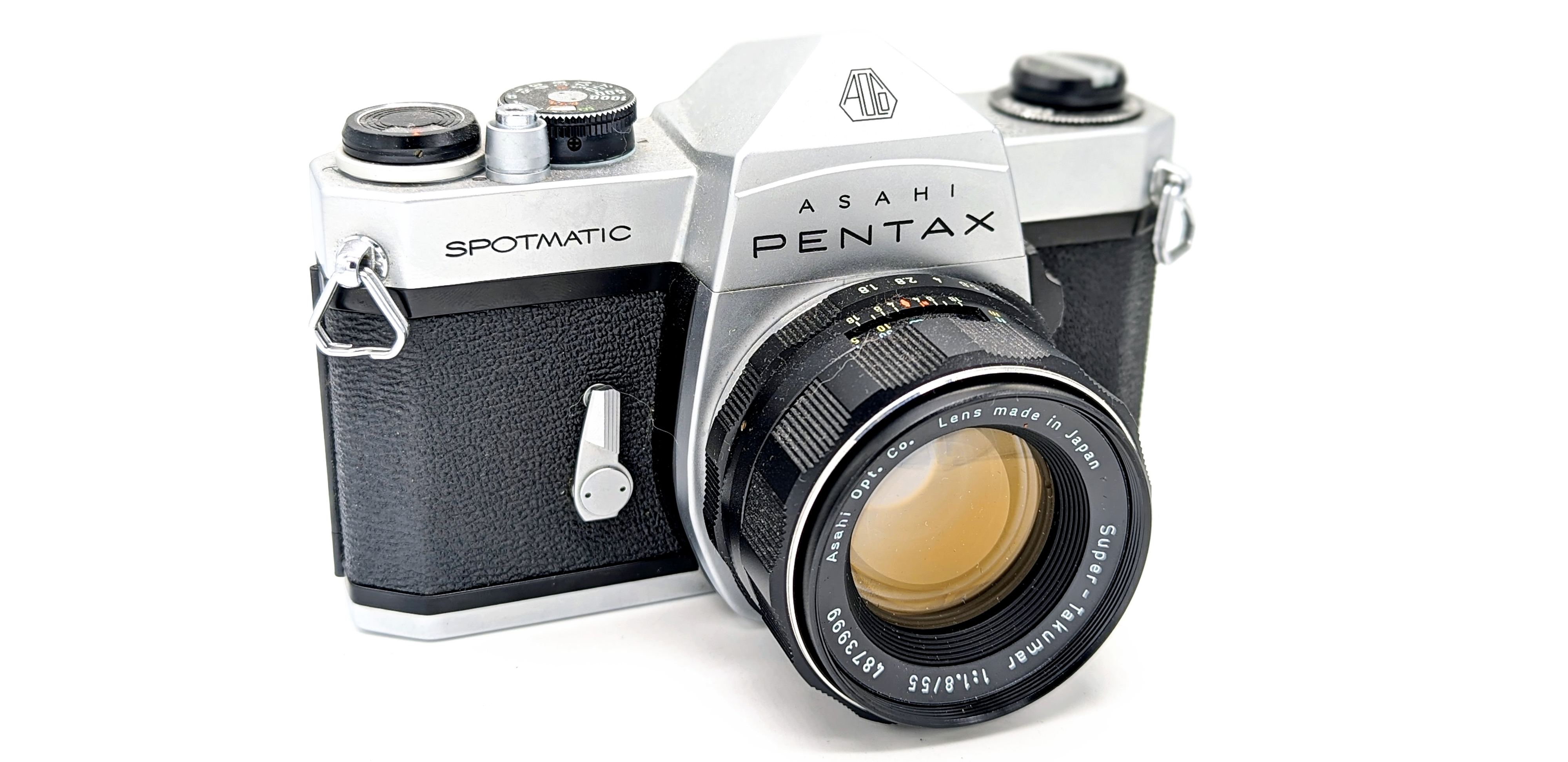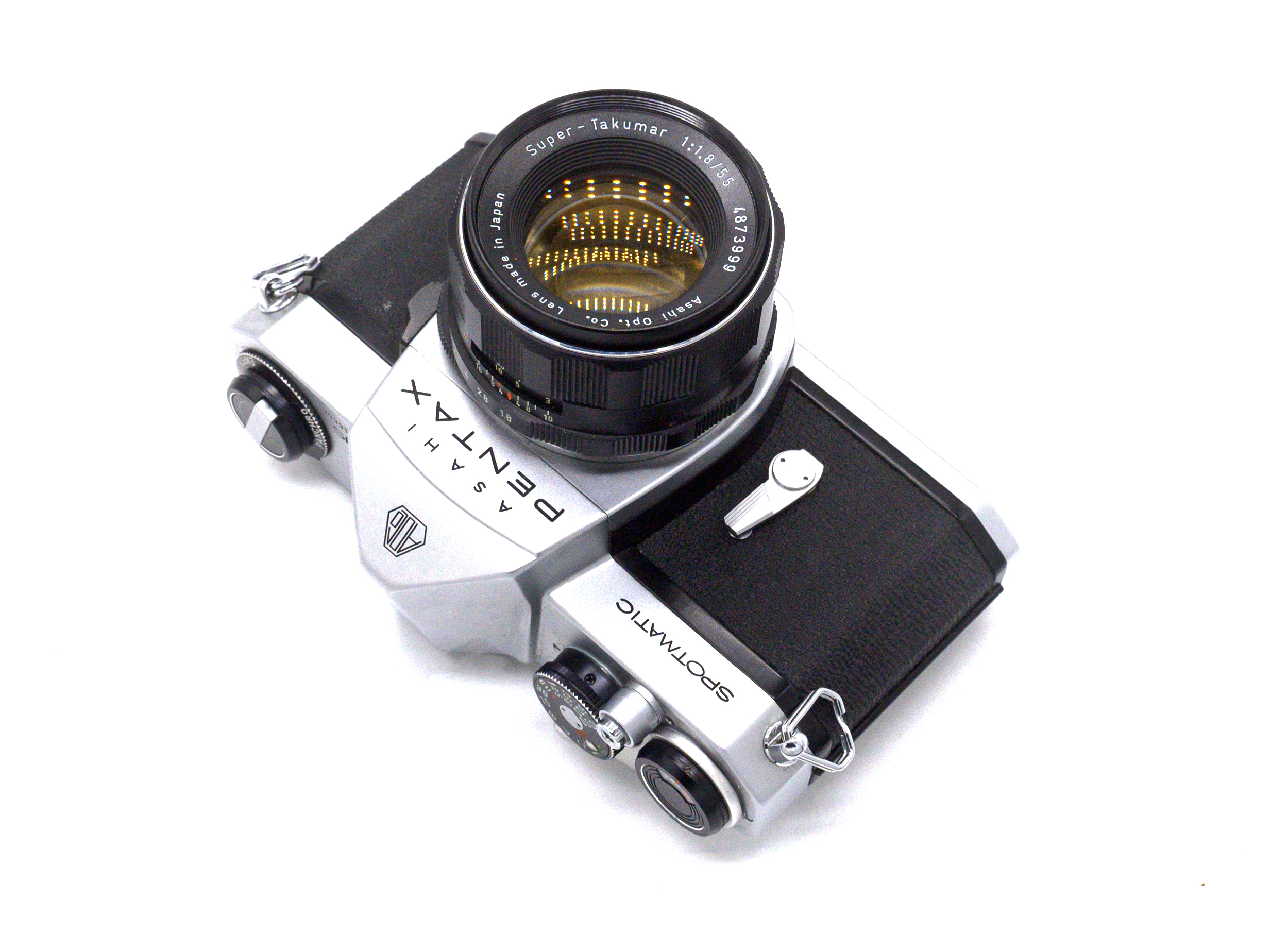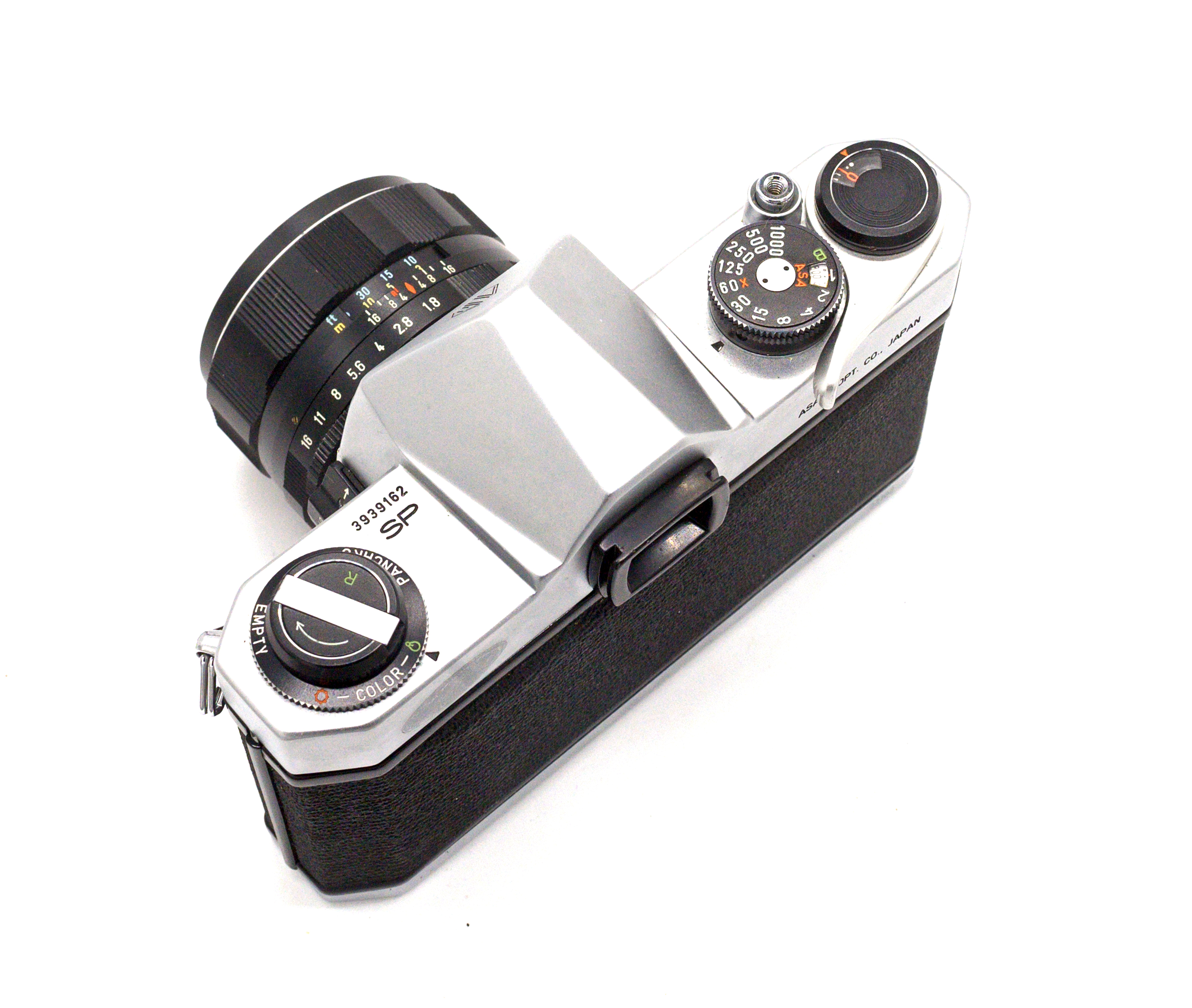
The 1964 Asahi Pentax Spotmatic SP was the first commercially-available M42 SLR that combined auto-diaphragm lens operation with TTL light metering, but in a rather cumbersome two-step process. This third generation M42 technology would be employed by countless models by numerous manufacturers from the mid 1960s through the late 1980s. Like the Nikon F before it, the SP has generated quite a lore around itself where many folks believe it was the “best” or one of the best M42 bodies ever made. Given the wide range of later and better M42 camera body alternatives, is there an objective case for the SP? Let’s find out.
The M42 lens mount standard was developed before WW2 but did not come into general commercial use until the late 1940s. In 1949, East Germany’s Contax introduced the first of its “S” line of M42 SLR cameras. Other East German products such as the “Praktica” and “Praktina” line also appeared during the late 1940s and early 1950s. For its part, Pentax also entered the race, claiming that its 1952 Asahiflex I was the first Japanese-built M42 SLR to reach market.
Throughout the 1950s, M42 camera technology rapidly developed with the East German and Pentax models being competitive with each other. During 1956, Contax announced its “F” camera that introduced “auto-diaphragm” operation with M42 lenses that contained an extra “stop down” pin that permitted the camera body to hold the lens’ aperture wide open for focusing while automatically stopping down to the selected aperture upon taking the shot. Pentax’s ultimate response was the 1958 Pentax K, an auto-diaphragm-capable camera with an integrated pentaprism and a lever film advance. In 1961, Pentax introduced the S3, which could use an optional detachable coupled light meter.
When introduced in 1964, the SP’s primary innovation was a built-in TTL light meter with a match-needle exposure system. From the outset, the Spotmatic system had broad range of professionally-oriented accessories as well as a full-range of lenses from 17mm to 1000mm. Although the SP came standard with either a 50mm f/1.4 or a 55mm f/1.8, it could function equally well with any auto-diaphragm M42 lens. Pentax continued producing the Spotmatic series in various forms until about 1975.
In 1971, Pentax introduced the first of the fifth generation” of M42 SLRs with its “ES.” The ES was the first electronic-shutter, aperture-priority autoexposure M42 camera. For the system to function properly, however, Pentax required the use of proprietary lenses that contained the necessary linkages to communicate the lens aperture to the camera.

Specifications
| Year Introduced | 1964 |
| Lens Mount | M42 |
| Shutter | Metal Focal Plane |
| Shutter Speeds | B, 1 sec. – 1/1000 |
| Viewfinder Magnification | 0.88x (50mm); 1.00x (55mm) |
| Focusing Screen | Fresnel / Microprism |
| ASA Range | 20-1600 |
| Weight | 621g |
| Flash X-Sync Speed | 1/60 |
| Battery | PX400; 387S (Modern Replacement) |
Operation
Like many marquee 35mm camera bodies of the 1960s, there is little question that the SP exhibits exceptional build quality and attention to detail. There is a strong case that the SP is among the best of the third generation of M42 cameras.
Operation: In 1964, the primary draw of the SP would have been its ability to use any auto-diaphragm M42 lens with true built-in TTL light metering. Remember that even the Nikon F and F2 require the use of an optional external prism for TTL metering. The SP employed a two-step procedure for it to work. Essentially, when an auto-diaphragm M42 lens is mounted, the camera body holds the aperture wide open for the purposes of easy focusing. To meter at a selected aperture, you press the switch at the side of the lens mount to turn on the meter and to stop down the lens to the taking aperture. A needle will then begin moving in the viewfinder, and you would change the aperture and shutter speed combination until the needle falls between the + and – signs. You then switch off the meter, which returns the lens to wide-open aperture. When triggering the shutter, the body automatically stops down the lens to the selected aperture. The shutter noise is not particularly quiet.
Viewfinder: The only information displayed in the viewfinder is the match-needle information on the right side of the screen. The fixed, non-interchangeable focusing screen is a fresnel / matte microprism type with a .88x magnification with the 50mm lens and 1.00x magnification with the 55mm lens. The focusing screen is not exceptionally bright, even with a f/1.8 lens, and is mostly par for the course for a 1960s camera of this type.
Lack of Flash Shoe: The SP did not come standard with either an integrated cold or hot shoe for a flash. A cold shoe adapter that fit over the camera’s viewfinder was an optional accessory. The SP has two flash sync sockets on the front of the camera for “X” and “FP.”
No Motor Drive Capability: The original SP does not have the appropriate linkages for the Pentax’s later motor drive. However, Pentax later produced in 1967 a variation of the SP called the “Spotmatic Motor Drive.” With a bottom-mounted unit, the camera could achieve 2-3 frames per second at 1/1000. Read all about this motor drive and the optional 250 frame back here.
Batteries: The SP used a single V400PX 1.35 mercury battery to power the meter. The most common alternative today would be a zinc air MRB400 1.35V battery. Many SP users claim that, unlike other 1960s cameras, the 1.55V of modern alkaline batteries will not throw off the camera’s meter. The closest alkaline equivalent that works appears to be a 387S, which is just a 394 battery with a rubber ring.
Shutter Speed / ISO Range: Typical for the era, the SP had shutters speeds of “B” and 1 second to 1/1000. No SLR camera of the 1960s, save for 1960 Konica F, the 1960 Canonflex R2000, and the 1964 Leicaflex, offered a faster shutter speed than 1/1000. ISO range is 20 to 1600.
Self-Timer: The SP has the standard mechanical front self-timer.
Exposure Lock: The SP has no external exposure lock and no manual exposure compensation.

Conclusions
In my opinion, the SP suffers a bit from “conventional wisdom” syndrome. While no doubt a quality-made and innovative SLR from an age where manufacturers placed more of a priority on aesthetics and durability, the SP has been completely eclipsed by several subsequent generations of M42 cameras. The main drawbacks for me are the cumbersome metering process and the relatively dark viewfinder with any lens slower than f/1.8, with the obscure battery thing being a secondary concern. This may be heresy to some, but if looking for a native film platform for M42 lenses, there are plenty of better options.
Thank you for this veneration of the Spotmati. I have a cpl bodies and lenses from my earliest time in photography.
They are antiquated as far as bodies go, but the quality of the lenses are the equal to anything. The late camera repair guru, Marty Forschner, once stated that the Takumar 50 mm lens was as good or better than most, including German. I have a Leica M3 and the lenses are not better than the Takumars. The color rendition of the Pentax lenses have proven to be high quality. I formerly had some German Zeiss Contax lenses that were the equal of my Takumars. These were 10 times or more expensive than the Pentax ones. I wound up shooting great chromes with the Pentax and relegated the Erntz Leitz (Leica) for B&W.
I later went to Nikon and Canon systems, settling on Nikon because stopping down was the same direction as the Pentaxes. Muscle memory ruled. If one is a student and wants to use film, you cannot go wrong with a Spotmatic and at least a 50mm f1.4!
I learned later in life that slide film requires perfect exposure, in the Navy I shot plenty of Kodachrome slide film with my Spotmatic, its meter was dead on everytime
This review ridiculous! Lete address a few things. When you are using your newer cameras in manual mode you wouldn’t use exposure compensation (at least I wouldn’t) as it is much easier dial in aperture or shutters speed). The only advantage of using exposure compensation would be that some modern cameras can shoot in between shutter speeds. This brings me to my second point. If you are relying on auto exposure solely you are giving up a lot of control. I will agree about the M4 lenses (universal thread mount) not being ideal, especially if you wish to change lenses fast but the lenses were amazing in clarity and color rendition. Lastly and this is a big deal for me, if your battery runs out on the Pentax SP, you will only lose your metering capability but the camera will still function. This is NOT the case with modern cameras. I still take a Cannon F with me on camera shoots just as a backup if all else fails. I have been saved by this more than once! The modern DSLR’s are not as rugged as we’re the mechanical cameras of the past. The Pentax SP, Canon F and Olympus OM-1 are some of the most durable cameras built. If you want to learn photography, I mean really learn, then get yourself one of these cameras!
I had a SpII, bought in 1969 or 70, used with A SMC Takumar 2.8/28 mainly. What I loved about this, and compared with the Canons and Nikons that friends had was the wonderful ergonomics and feel of it. It was much more comfortable to use, and I just loved it. I suppose one had to be there!
I replied to myself!